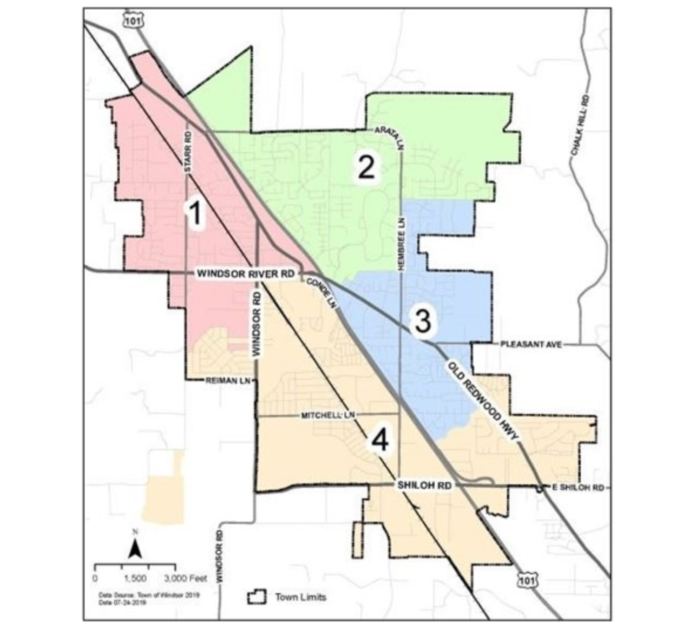The findings mean districts are here to stay
Note from the editors: This article uses the term “Hispanic” when referring to persons of Latin-American descent to conform with the language of the study and U.S. Census data referenced.
A return to Windsor’s former at-large election system would likely violate the California Voting Rights Act (CVRA), dashing hopes that the current and heavily criticized by-district voting system could be abandoned, according to a study completed by consultants Best, Best and Krieger (BBK).
The town council received a presentation on the study at its Nov. 17 meeting, and the study itself has been reviewed by SoCoNews.
Conducted through BBK’s redistricting and demographics expert HaystaqDNA, the study analyzed voting outcomes in 23 state and federal elections between 2012 and 2020 and found, through a statistical method called ecological inference, that the town’s electorate met three conditions that would require it to maintain the by-district system or be found in violation of the CVRA. The study did not look at actual Windsor council elections, but rather extrapolated using statistical analyses to make inferences about Windsor’s elections. The method used is the method that the CVRA relies on to determine compliance.
The three conditions that require maintenance of the by-district system — the existence of racially polarized voting, vote dilution and an ability of the town to create majority-minority districts — will be explored in depth below.
From the study: “Based upon the evidence we saw from examining the elections listed above, we found (racially) polarized voting and vote dilution in Windsor. In elections that we analyzed going back to 2012, we found that the Hispanic voting bloc preference for candidates and ballot measure choice was significantly different from the preference for candidates and measure choices made by the rest of the electorate. In addition, in many of these cases the Hispanic voting bloc was unable to elect its choice because the non-Hispanic voting bloc cast more votes that overwhelmed the Hispanic bloc’s vote.”
The findings corroborate the town council’s 2019 decision to switch to district-based elections and definitively quash any hopes of going back to an at-large system.
A brief history of Windsor’s by-district system
Prior to 2019, the Windsor Town Council had five council members, each of which was elected to four-year terms in at-large — or town-wide — elections. Half of the council seats (two or three) would be up for contest every two years, and following each election, the five-member council would meet and appoint a mayor from among themselves to serve for two years until the next municipal election.
In 2019 the Town of Windsor replaced its at-large election system with a by-district system, which divides the town into four geographical districts, each represented by a specific council seat. Each of the four councilmembers is selected by the district they represent, which is to say, voters in District 3 cannot cast votes for candidates in District 1, 2 or 4. In the current system, the fifth council member is the mayor, who presides over meetings and votes with the same weight as the four council members, but who is selected every two years via an at-large vote—that is, every Windsor voter votes for the mayor every two years regardless of their district.
Earlier this year, the town council directed BBK to conduct a “racial polarization study,” which would determine whether the town’s previous at-large system had, in actuality, violated the CVRA.
Following last spring’s scandals involving Dominic Foppoli, Windsor’s first mayor selected by the at-large vote, a related but separate debate over whether to reinstitute an appointed mayor with five by-district council seats is underway concurrently.
The town is currently in the process of redrawing its four districts with updated data from the 2020 U.S. Census. If the council eventually votes to abolish the at-large mayoral system by a town-wide special election, and Windsor voters back the change, the districts would have to be redrawn again to include five CVRA-complaint districts.
The study’s findings
The 2018 lawsuit alleged that the Town of Windsor violated the CVRA by marginalizing Hispanic voters. Based on 2020 U.S. Census data released this fall, 8,903 (33.7%) of Windsor’s total population of 26,378 identify as Hispanic.
Whether the town’s at-large system was, in actuality, violating the CVRA depends upon three conditions.
The first condition, confirmed by the study, is the presence of racially polarized voting, which means that voting behaviors correspond to racial identification — that Windsor’s white and Latino residents vote differently.
Scott Smith, special counsel attorney with BBK, walked the council through a specific election to demonstrate this point: the 2018 race for California state insurance commissioner between Democrat Ricardo Lara and Republican Steve Poizner, in which nearly every single Hispanic voter in Windsor, based on extrapolations through the ecological inference analysis, can be assumed to have voted for Lara. Conversely, there was a weaker, but still strong, positive correlation between non-Hispanic voters and voting for Poizner.
The example, noted in the study as well, showed that “there is a perfect inverse relationship in the ways Hispanic voters behaved in regards to these two candidates compared to non-Hispanic voters,” Smith said. “This is actually a very striking case. This data suggests virtually every single Hispanic voter voted for (Lara).”
But racially polarized voting alone may not have been enough to “run afoul” of the CVRA; however, the study also confirmed the presence of the second condition: vote dilution.
Vote dilution can occur in an at-large voting system when candidates preferred by the minority group (in this case, Windsor’s Hispanic population) are unfairly and disproportionately beaten out by candidates preferred by the majority (Windsor’s non-Hispanic population).
According to the study, this occurs, to at least some degree, in Windsor, resulting in a certain disenfranchisement of the Hispanic population, as their racially polarized votes are drowned out in at-large elections by the non-Hispanic majority.
“We find evidence of vote dilution in Windsor, as the preferred candidate of the protected class, voters of Hispanic or Latino origin, were not able to elect their preferred candidate or influence the outcome of ballot measures” the study reads.
Smith said these two conditions were enough to violate the CVRA. “When you reach either of these conclusions, then you’re required by the CVRA to convert to by-district elections.”
Since last spring, Windsor officials have been questioning whether the adoption of a district-based system, done rapidly under threat of lawsuit claiming the at-large process marginalized Latino voters in violation of the California Voting Rights Act (CVRA), was truly necessary.
Minority-majority districts in Windsor
A final condition, discussed at a special town council meeting Sept. 27and by the study but absent from the Nov. 17 presentation, relates to the distribution of the minority Hispanic population. District-based systems can increase representation of certain groups through the creation of minority-majority districts, which are geographical areas in which the minority group constitutes a majority.
At the Sept. 27 meeting, prior to the completion of the racial polarization study, a consultant with BBK said that it may be impossible for such a minority-majority district to be drawn in Windsor, due to the somewhat ubiquitous distribution of the Hispanic population in the town.
“(The Hispanic population) is evenly dispersed throughout (the Windsor) community, so if we left the boundaries the way they are, they would be compliant with the (elections laws) because they do not disenfranchise minority voters, because we don’t have the ability to create a minority-majority district,” the consultant said.
However, the study found that this was not true: “It is possible to draw a majority-minority, or over 50% Hispanic district in the town of Windsor with four districts.” The redistricting process will continue into next year with many opportunities for public input on how the town should divide itself.
With the racial polarization study confirming the 2018 lawsuit’s claims, Scott Smith, of BBK, said, “The takeaways are these: that the Windsor Town Council made a very good bet in its decision to convert to district elections. With this available data, I think you have an even more compelling case.”
Council reaction
At the Nov. 17 meeting, following the presentation, Councilmembers Esther Lemus and Debora Fudge were happy to share the determination with the public so they would understand the change to the elections was a necessary choice.
“I appreciate that we are now presenting this information to the public so that people fully understand that we can’t go back and why. I know it was controversial when we first converted to district elections, and some people still feel strongly against district elections. But I think our attorney has clearly laid out that we would not be successful with a challenge,” Councilmember Lemus said.
Councilmember Debora Fudge said, “I think we did the right thing for Windsor. I’m happy that we did it and didn’t fight it, and now we can explain to the public that we have served our residents well. There was so much angst involved, and now I think we all feel pretty peaceful that we did the right thing and now we can represent everyone fairly.”
Mayor Sam Salmon said he was wary of the district system because of the relatively small sizes of the individual district electorates. Vice Mayor Rosa Reynoza made no comment on the findings.
As Latina women, Councilmember Lemus, elected in 2018, and Vice Mayor Reynoza, elected by special election last June, had been held up by community members and officials as evidence that Windsor’s Hispanic population was not marginalized. There was no mention of this point at the Nov. 17 meeting, however, it’s clear that the presence of Hispanic representatives on a governing body does not exempt Windsor from the CVRA when racially polarized voting and vote dilution are present.









